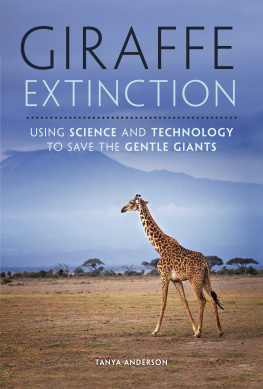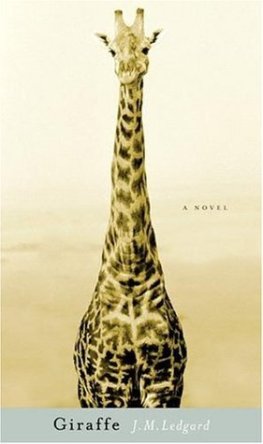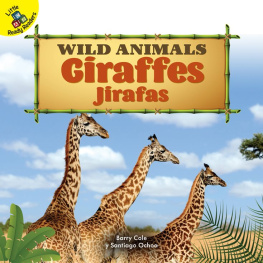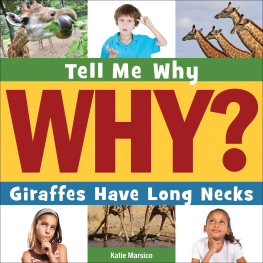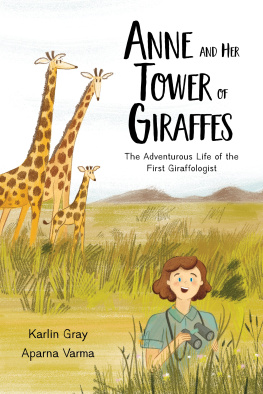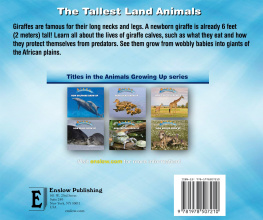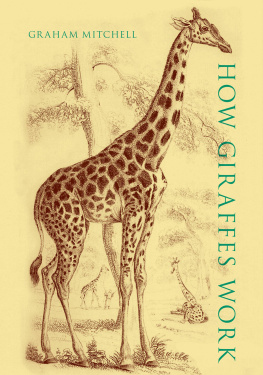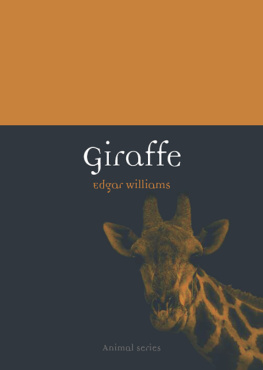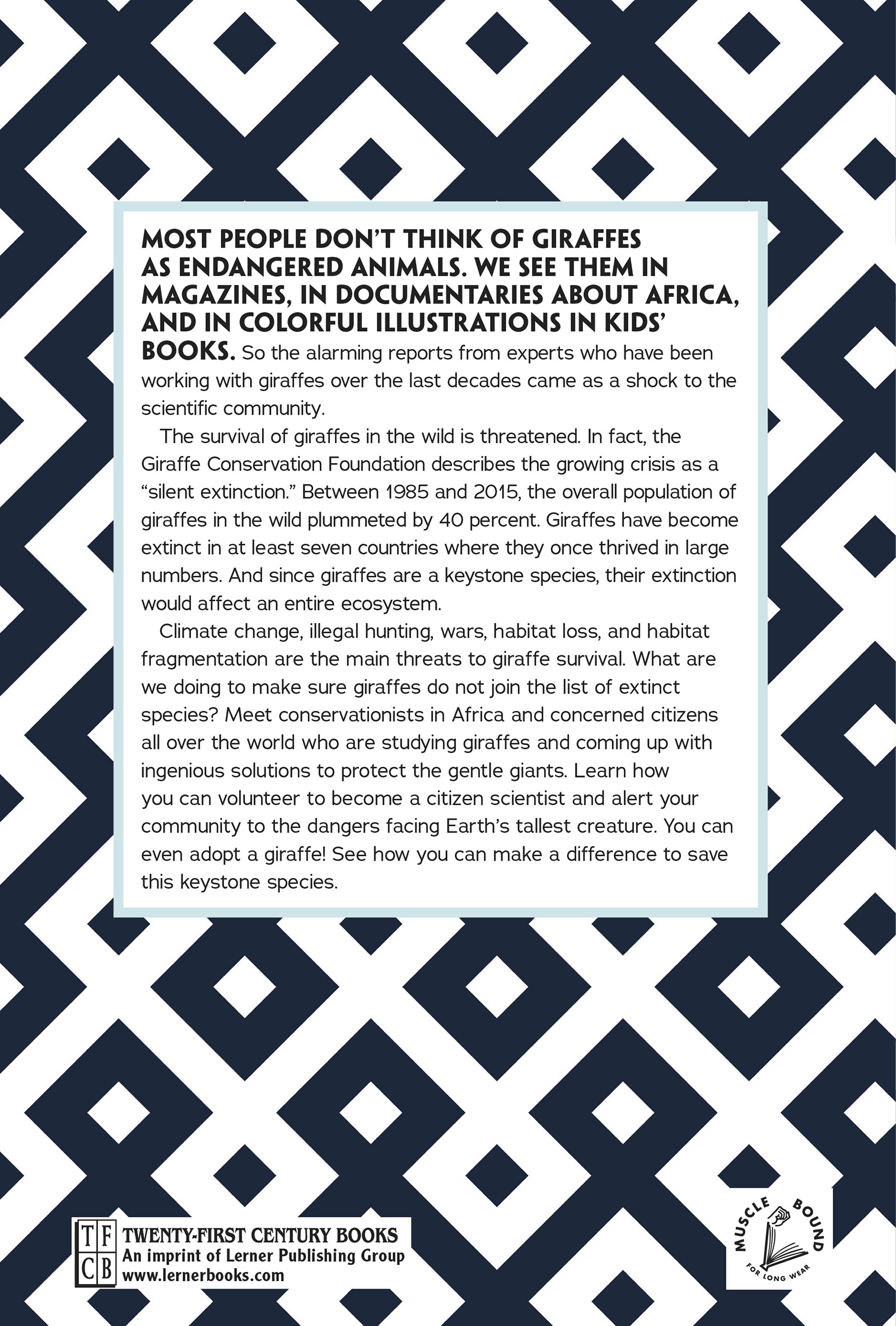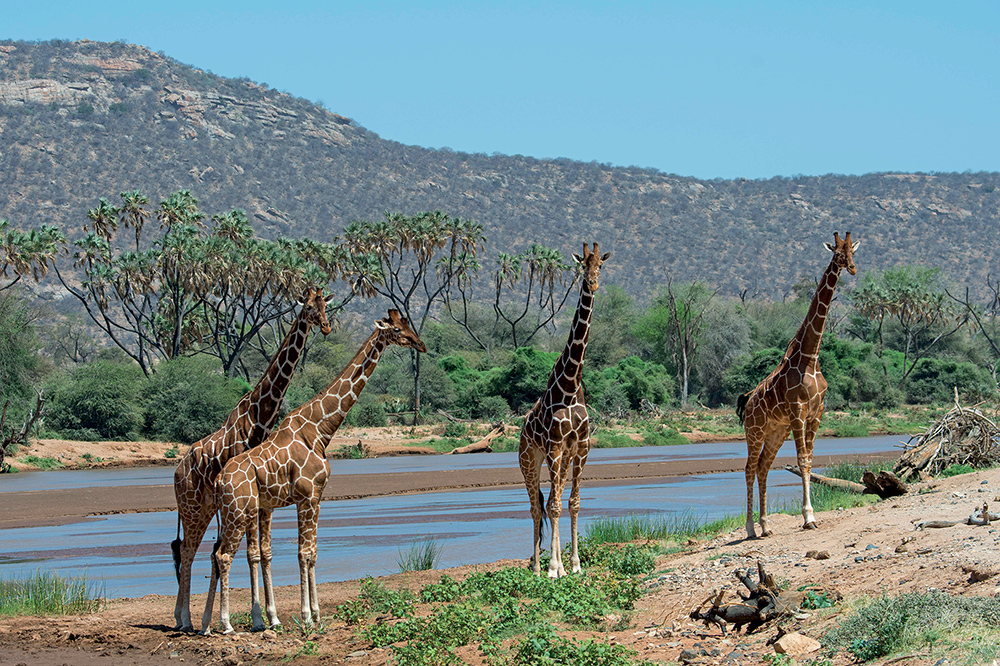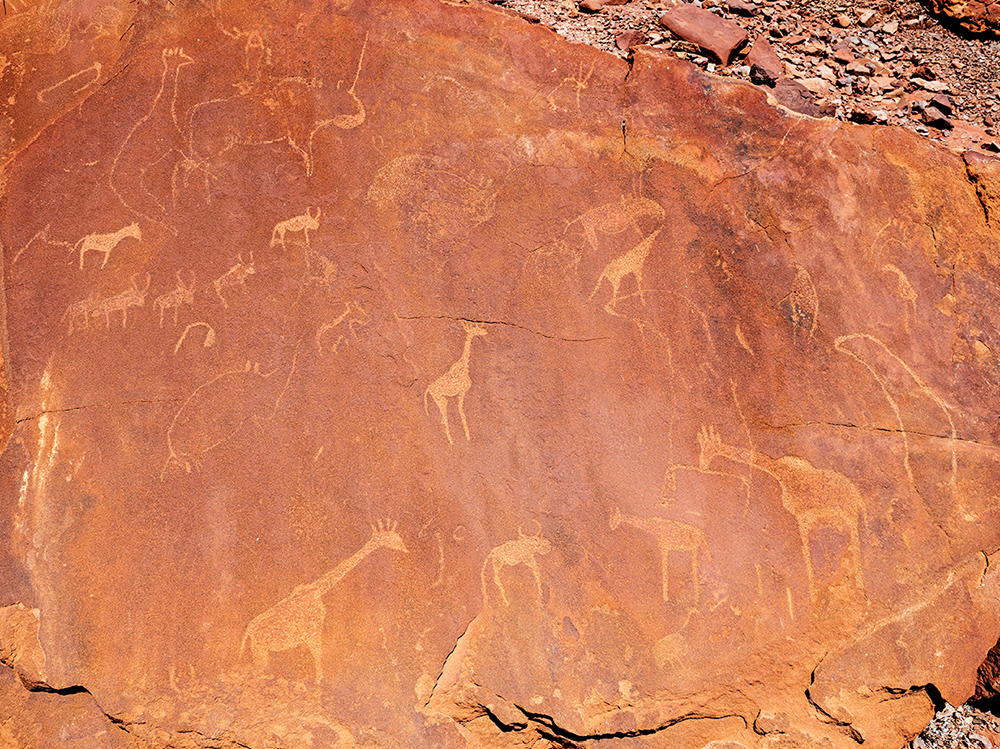To Anne Innis Dagg, the pioneer of giraffe research
To Dr. Julian Fennessy, Stephanie Fennessy, and Dr. Zoe Mulleryour generosity of time and information made this book possible
To all of the wonderful, dedicated people who are working hard to save the giraffes in Africa
Text copyright 2020 by Tanya Anderson
All rights reserved. International copyright secured. No part of this book may be reproduced, stored in a retrieval system, or transmitted in any form or by any meanselectronic, mechanical, photocopying, recording, or otherwisewithout the prior written permission of Lerner Publishing Group, Inc., except for the inclusion of brief quotations in an acknowledged review .
Twenty-First Century Books
An imprint of Lerner Publishing Group, Inc.
241 First Avenue North
Minneapolis, MN 55401 USA
For reading levels and more information, look up this title at www.lernerbooks.com .
Main body text set in Adobe Garamond Pro.
Typeface provided by Adobe Systems.
Library of Congress Cataloging-in-Publication Data
Names: Anderson, Tanya, author.
Title: Giraffe extinctio n : using science and technology to save the gentle giants / Tanya Anderson.
Description: Minneapoli s : Twenty-First Century Books, [2020 ] | Audience: Age 1319 . | Audience: Grade 9 to 12 . | Includes bibliographical references and index . |
Identifiers: LCCN 2018054714 (print ) | LCCN 2018056497 (ebook ) | ISBN 781541562660 (eb pdf ) | ISBN 781541532380 (l b : alk. paper)
Subjects: LCSH: GiraffeConservationJuvenile literature . | Endangered speciesConservationJuvenile literature.
Classification: LCC QL737.U56 (ebook ) | LCC QL737.U56 A55 2020 (print ) | DDC 599.638dc23
LC record available at https://lccn.loc.gov/2018054714
Manufactured in the United States of America
1-44839-35710-3/26/2019
Contents
Chapter 1
Disappearing Shadows
Chapter 2
Tracking Down the Numbers
Chapter 3
Science Has Some Surprises
Chapter 4
Habitat Loss and Fragmentation
Chapter 5
Human Violence and Climate Change
Chapter 6
The Good News of Giraffe Conservation
Chapter 7
Speaking Up for Giraffes
Chapter 1
Disappearing Shadows
I had time after time watched the progression across the plain of the giraffe, in their queer, inimitable, vegetative gracefulness as if it were not a herd of animals but a family of rare, long-stemmed, speckled, gigantic flowers slowly advancing. It was in giant size, the border of a very old, infinitely precious Persian carpet in the dyes of green, yellow, and black-brown.
Isak Dinesen, Out of Africa
D anish writer Isak Dinesen had the privilege of watching giraffes in their native African landscapes. She and others who have shared the same pleasure say the experience moved and even changed them. No other creatures on Earth can compare to these gentle giants. Their unusual beauty and mysterious behaviors have captured the imaginations of people for thousands of years. More than ten thousand years ago, ancient tribespeople of the African continent etched into giant rock images of thin, long-necked animals covered in spots. Later, Egyptian pharaohs and then Roman rulers included live giraffes in elaborate triumphal parades. Rulers of ancient Middle Eastern empires offered live giraffes as gifts to leaders they wanted to impress, sending the delicate giants as far away as China and Europe.
Giraffes are native to the grassy plains of Africa south of the Sahara. This tower (group) of reticulated giraffes are at the Ewaso Nyiro River in the Samburu National Reserve in Kenya.
In more modern times, big-game hunters tracked down giraffes as one of the most coveted trophy animals. In the late nineteenth century, giraffes were hunted almost to extinction. By 1906 giraffes were some of the rarest of species in South Africa.
Giraffes remain an iconic symbol of Africas rich and varied wildlife. Zoos around the world have always included giraffes in their popular menageries. Visitors love to get a real-life look at the worlds tallest animal. Giraffes may have become familiar wildlife to most people, but they have never lost their mystique or their ability to impress anyone who takes a good look into their big, dark eyes.
Most of us assumed giraffes would always be with us. We saw their images in magazines, in film footage of documentaries about Africa, as a part of logos for childrens toys, and in colorful illustrations in coloring books and childrens literature. So reports that the survival of giraffes in the wild is threatened, coming from experts who have been working with giraffes over the last several years, came as a shock.
Giraffe petroglyphs cover rock surfaces at the Twyfelfontein site in northwestern Namibia. The site has one of the largest numbers of petroglyphs in Africa. In 2007 the United Nations Educational, Scientific and Cultural Organization (UNESCO) approved it as a World Heritage Site.
The survival of giraffes is critical because the giraffe is a keystone species and ranks among the megafauna, or large animals, on the savannas, or grassy plains, of Africa. A keystone species is one upon which other species in an ecosystem largely depend. If that species were to disappear, the ecosystem would change drastically. Giraffes eat the leaves and twigs from near the top of acacia trees, and as the animals forage for food, they naturally prune the trees. Giraffes inadvertently eat the seeds from these trees too. Giraffe dung deposits the seeds on the ground where new trees can then grow. Without giraffes, the savannas would have far fewer acacia trees. The landscape and other wildlife that depend on the trees would lose an important source of food, shade, and nesting material.
The Namibia-based Giraffe Conservation Foundation describes the growing giraffe crisis as a silent extinction. The foundation and other conservation organizations and giraffe experts have been following and watching these animals and documenting and analyzing data about them. Their conclusions are cause for alarm. Within just thirty years, from 1985 to 2015, the overall population of giraffes in the wild plummeted by 40 percent. In 1985 between 150,000 and 163,000 giraffes roamed the African savannas. By 2015 fewer than 98,000 giraffes existed in the wild. Giraffes have become extinct in at least seven countries where they once made their home.
These gentle giants have been overlooked. Its well known that African elephants are in trouble, and there are perhaps just under half a million left. But what no one has [realized] is there are far fewer giraffes, which have already become extinct in seven countries.
David Attenborough, British naturalist, 2016
What Happened?

